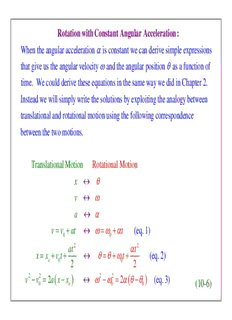
Rotation with Constant Angular Acceleration PDF
Preview Rotation with Constant Angular Acceleration
Rotation with Constant Angular Acceleration : When the angular acceleration is constant we can derive simple expressions that give us the angular velocity and the angular position as a function of time. We could derive these equations in the same way we did in Chapter 2. Instead we will simply write the solutions by exploiting the analogy between translational and rotational motion using the following correspondence between the two motions. Translational Motion Rotational Motion x v a v v at t (eq. 1) 0 0 at2 t2 x x v t t (eq. 2) o 0 0 2 2 v2 v2 2ax x 2 2 2 (eq. 3) (10-6) 0 o 0 0 Example: An electric motor rotating a grinding wheel at 100 rev/min is switched off. Assuming constant negative angular acceleration of magnitude 2.00 rad/s2, (a) How long does it take the wheel to stop? (b) Through how many radians does it turn during the time found in (a)? Example: An electric motor rotating a grinding wheel at 100 rev/min is switched off. Assuming constant negative angular acceleration of magnitude 2.00 rad/s2, (a) How long does it take the wheel to stop? (b) Through how many radians does it turn during the time found in (a)? When the wheel has stopped then of course its angular velocity is zero Example: As shown in the figure, three masses, of 1.5 kg each, are fastened at fixed position to a very light rod pivoted at one end. Find the moment of inertia for the rotation axes shown. Pivot Axis (1,0) (2,0) (3,0) 3 2 2 2 2 I r m r m r m r m i i 1 1 2 2 3 3 i 2 2 2 2 2 2 2 m (r r r ) 1.5(1 2 3 ) 21 kg.m 1 2 3 Example: Calculate the rotational inertia of a wheel that has a kinetic energy of 24, 400 J when rotating at 602 rev/min.
Description: